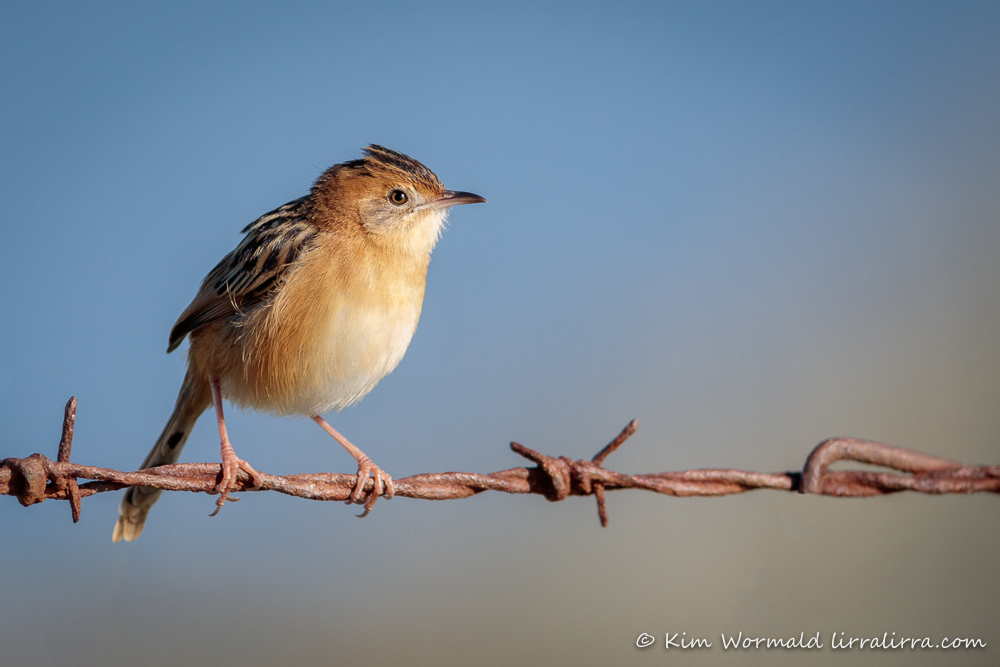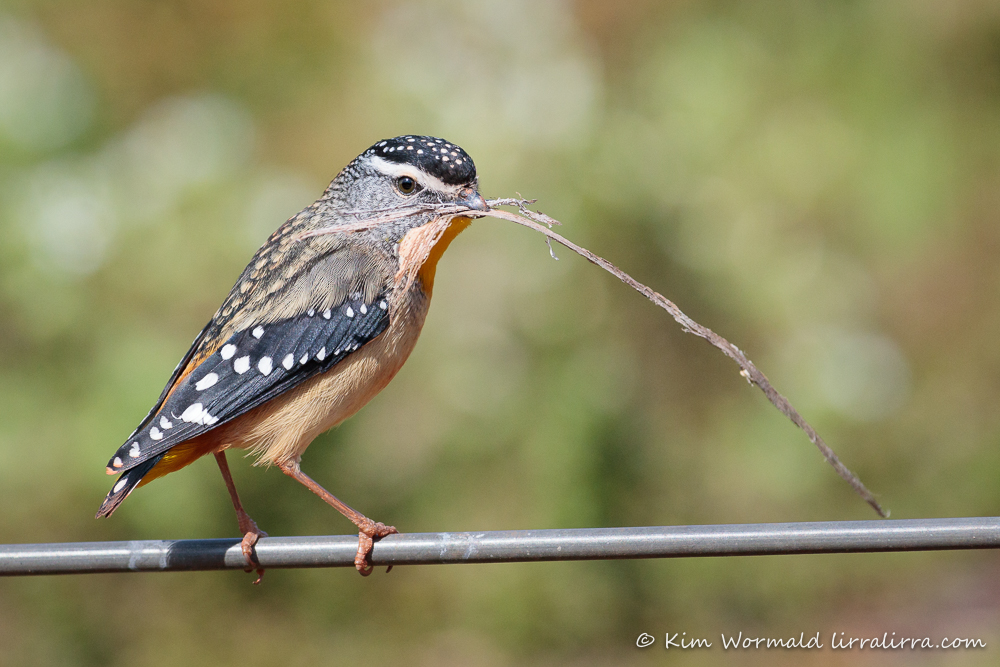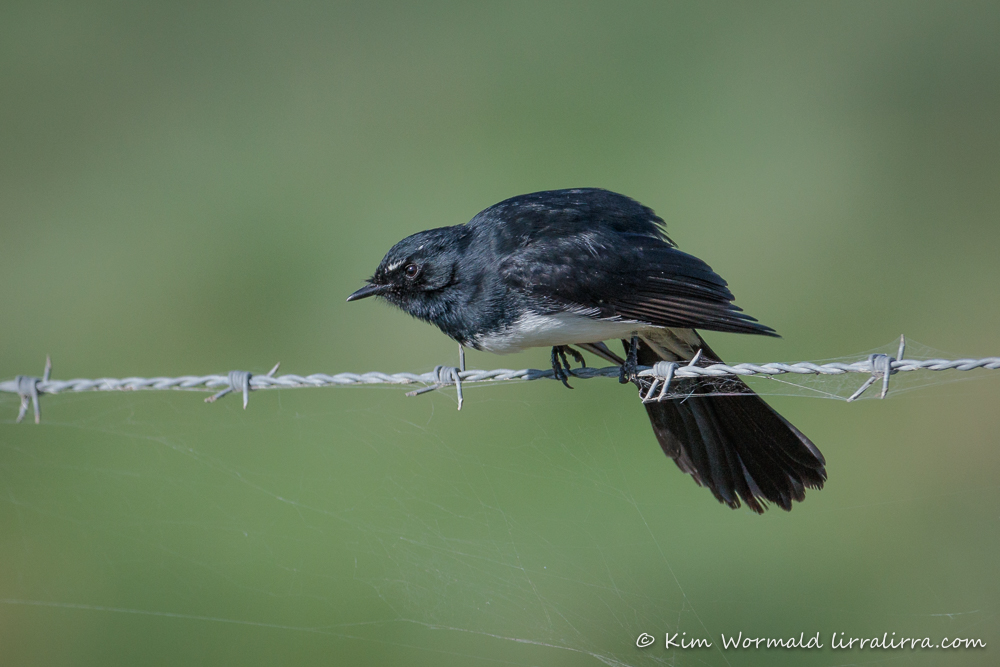Golden-headed Cisticola, Spotted Pardalote and a Willie Wagtail on aesthetically differing wire perches.
 Golden-headed Cisticola (Cisticola exilis)
Golden-headed Cisticola (Cisticola exilis)
1/2000, f5.6, ISO 800
I adore Golden-headed Cisticola, and I abhor barbed wire but when it’s rusty it evokes some kind of unjustified bucolic sentiment. Years ago I looked after a mumma Common Ringtail Possum with two sweet joeys. She’d been found caught on barbed wire which had ripped her pouch beyond repair. When I moved to my current property I delighted in removing the barbed wire that topped the fence line. The ringtails were beautiful creatures and I enjoyed the time they spent living in my laundry eating fruit, native plants and rose petals.
Golden-headed Cisticola are about 10cm and 10g, exquisite and tiny. The cisticola above is a non-breeding, adult female. I like the way her rusty colouring complements the wire.
I’ve been to the Werribee Western Treatment Plant twice in the past couple of weeks. The first time it was a Golden-headed Cisticola paradise, I was so enamoured that I went back shortly afterwards and saw a couple of cisticola in the distance – nature can be crazily unpredictable.

Spotted Pardalote (Pardalotus punctatus)
1/2500, f8.0, ISO 1600
Spotted Pardalotes are arguably one of Australia’s most beautiful birds. I’d stopped to check images when this male landed nearby before flying off to continue preparing its nest chamber. Spotted Pardalotes are slightly smaller than cisticolas at 9cm and 8g.
There is nothing interesting about the wire … well, as soon as I wrote that I went off on a merry goose chase trying to work out the gauge and quote it as a scale relating to the size of the bird. I started off thinking maybe it’s 5mm but that makes the pardalote bigger than 9cm and I can’t find a standard 8mm wire, even horse sighter wire is only 5.2mm. Then I checked the web for standard wire gauges and that has been taking far too long if I’m going to get this post published before midnight. A pardalote’s bill measures between 6mm and 9mm which hasn’t helped much either. A bird-watching rural fencer would be able to solve this problem this in their sleep!

Willie Wagtail (Rhipidura leucophrys)
1/2000, f7.1, ISO 800
There is nothing vaguely attractive about new barbed wire, I wish it could be banned, but I was stoked to capture this shot of a Willie Wagtail with one foot already off the perch as it launches itself into flight.
Willie Wagtails are about twice the size of Spotted Pardalotes and Golden-headed Cisticola, which is neat to think of considering the wagtails are smallish birds too.
Images entered in the Nature category of accredited international and national salons cannot include anything relating to humans unless it’s part of the nature story. The examples of what ‘hand of man’ elements are acceptable include Barn Owls in barns and storks on chimneys. In that spirit I often think that small birds on fences and fence posts should be acceptable but perches are often a significant part of the image and fences aren’t always attractive.
Happy birding
Kim
Whistling Kite Portraits – many thanks for all the brilliant feedback on last week’s post. I had hoped to have time to collate the responses, I’m not sure yet whether there was a clear ‘winner’ but I’ll aim to report back next week.
~ thank you for visiting and commenting
~ use the subscribe box if you’d like to receive a weekly email when lirralirra is updated

These are beautiful Kim. Such lovely work you do.
Thanks Sue
Great photos. Love it that these birds spot you and your camera and you are so quick to catch them.
Hi Joyce, I think this message was meant for another page, thank you
Like you Kim, I love Golden-headed Cisticolas. Living so much closer to the WTP than you, I have no excuse not to visit this fabulous bird sanctuary save my busyness and bad weather. I’ll have to make the time though, as your photos are so beautiful I want to share in the delight of seeing so many great photo opportunities. Keep up the great photography.
Maybe we’ll meet there one day! I’d like that
Sigh on the continued presence of ‘devil wire’, rusty or not.
Love, love, love each of the pint-sized charmers you have given us this week.
Thank you EC. I was amazed to find out a bit more about the history of barbed wire and its numerous iterations